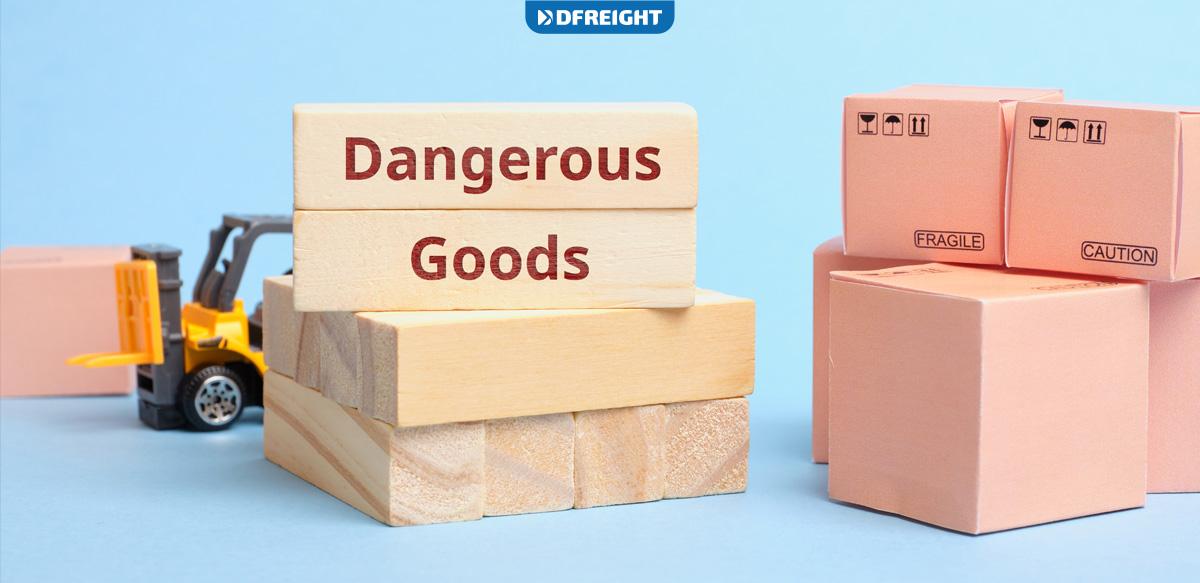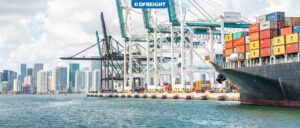Importing and exporting dangerous goods in the UAE is one of the most significant considerations that every trading company must consider while shipping goods, regardless of the mode of transportation. Being informed of the latest rules and regulations will help you go through the shipping process much easier and faster. If you are curious to get a clue, keep reading to learn what dangerous goods are and what categories they fall into. We will also provide a simple 5-step guide to facilitate shipping such goods in the United Arab Emirates.
Table of Contents
A Definition of Dangerous Goods
The term “dangerous goods,” also called “prohibited items,” refers to substances or things having potentially dangerous qualities that, if not adequately managed, pose a risk to the infrastructure, the health and safety of people, and/or their modes of transportation.
Dangerous commodities, often known as hazardous materials, might include pure chemicals, mixes of substances, manufactured goods, or other items that, if improperly used or transported, could endanger humans, animals, or the environment.
List of the 9 Classes of Dangerous Goods
There are nine major categories for shipping dangerous goods:
Class 1: Explosives
Although explosives have the potential to behave violently when adequately triggered, they are made to be pretty stable and insensitive on a typical surface. As long as they are not subjected to a tremendous shock, such as in a high-speed traffic collision, or worse, allowed to grow hot in a fire, they may be safely handled and carried by land and sea. Temperatures as low as 200o can ignite some high explosives. The Class has six divisions as the following:
| Class Division | Description |
| Class 1.1 | Mass Explosion Hazard |
| Class 1.2 | Projection Hazard Only |
| Class 1.3 | Fire Hazard and Minor Blast or Minor Projection Hazard |
| Class 1.4 | Minimal Hazard |
| Class 1.5 | Blasting Agents |
| Class 1.6 | Very Insensitive Detonating Articles |
Class 2: Gases
Gases typically weigh more than air. If they displace or muddle air in small areas, they may suffocate someone.
These consist of argon, oxygen, nitrogen, hydrogen, helium, and hydrogen. They must be kept in specialized, highly insulated containers to prevent them from warming up after becoming a liquid. If cold metal, etc., is unintentionally contacted without protection, the extreme cold causes a threat. A very cold gas escape also poses a danger to respiration, endangering the lungs directly or resulting in localized oxygen deprivation.
Apart from the physical risks, gases can pose chemical risks, such as those posed by toxic gases like chlorine and ammonia, as well as combustible gases like butane and acetylene. As a result, the Class has three Divisions:
| Class | Description |
| Class 2.1 | Flammable Gases |
| Class 2.2 | Non-Flammable, Non-Toxic Gases |
| Class 2.3 | Toxic Gases |
Class 3: Flammable Liquids
Petrol and kerosene are two examples of flammable liquids that come from petroleum. Others, like alcohols, are produced through industrial or natural methods. Highly rigorous restrictions govern the storage and shipping of flammable liquids as dangerous goods. Flammable liquids are organized into three Packing Groups according to boiling point and flash point.
| Packing Group | Initial Boiling Point | Flashpoint |
| Packing Group I | Boiling Point Below 35º C | |
| Packing Group II | Boiling Point Above 35º C | Flashpoint Below 23º C |
| Packing Group III | Boiling Point Above 35º C | Flashpoint >23º C and <>º C |
Class 4: Flammable Solids
More than common combustible materials like wood and paper, flammable solids burn readily. The burning could be intense and quick, producing a lot of heat. Desensitized explosives make up some of the 4.1, such as wet trinitrotoluene (TNT), which would typically fall under Class 1. Some materials are chemically unstable and prone to disintegrating when heated above a particular point, shocked, etc. They might burn vigorously, decompose explosively, or release poisonous fumes or gases.
Products falling under Division 4.2 spontaneously burn when exposed to oxygen. They must be stored either as liquids or in airtight containers beneath an inert gas or liquid blanket. Pyrophoric substances are always classified as belonging to packing group I because they will catch fire if exposed to air for five minutes. Other materials ignite only in enormous quantities and after long periods. Depending on the classification tests, these are in Packing Group II or III.
Products from Division 4.3 react with water to produce combustible gas as a liquid or a vapor. The heat of the reaction has the potential to ignite this. To prevent the entry of moisture or water vapor, they must be stored in hermetically sealed waterproof containers.
| Class | Description |
| Class 4.1 | General Flammable Solids |
| Class 4.2 | Spontaneously Combustible |
| Class 4.3 | Dangerous When Wet |
Class 5: Oxidizing Substances
Intense heating can make some oxidizers explosive, especially when carbon is present. Ammonium nitrate is a potent explosive frequently employed by terrorists and extractive industries when combined with hydrocarbon oil, such as diesel.
Ammonium nitrate is widely accessible since it is produced in vast amounts worldwide as an agricultural fertilizer to provide additional nitrogen to the crops. Direct nitrate absorption by plants results in nitrogen extraction for protein synthesis.
Organic Peroxides frequently need to be kept in refrigeration, where the temperature must be carefully managed. Otherwise, they will begin to break down quickly if the temperature rises above a particular point specifically to the material, much as the self-reactive materials in Class 4.1, leading to an unregulated progression toward fire or explosion.
Oxidizers can seriously harm the human body, especially the eyes because they are reactive.
| Class | Description |
| Class 5.1 | Oxidizing Agents |
| Class 5.2 | Organic Peroxides |
Class 6: Toxic and Infectious Substances
These chemical toxins and infectious substances can wholly or partially harm the human body. They must not be permitted to enter the body through breathing in, ingesting, or skin absorption.
The potency of the toxics ranges from those that can kill in a matter of minutes, like cyanides, to those that could hurt but wouldn’t necessarily kill, provided the dose wasn’t too high, like chlorinated hydrocarbons. Class 6.1 toxics come in solid and liquid forms, but Class 2.3 includes toxic gases.
Products that include pathogens—microorganisms that cause infectious disease in people or animals—are referred to as infectious substances. They are divided into one of three groups based on how harmful it is to move them, with only the first two being so for contagious reasons.
| Class | Description |
| Class 6.1 | Toxics |
| Class 6.2 | Infectious Substances |
Class 7: Radioactives
Dangerous goods like radioactive materials contain substances with unstable atoms that spontaneously and randomly alter their structure throughout time.
Each time an atom changes, it generates ionizing radiation, invisible radiation that can alter chemical or biological processes. Depending on the radiation type and the length of exposure, this may cause harm to the human body in one way or another.
Because the packaging serves as a shield, handling and transporting radioactive goods is safe. They won’t pose any health risks like other dangerous goods to those who work in transportation. Nevertheless, the rule is to limit any ionizing radiation exposure to a minimum.
Class 8: Corrosives
These highly reactive materials produce positive chemical effects, resulting in changes in the affected materials. For this reason, corrosives are used extensively in industry to create a wide range of transformations and effects.
Corrosives are classified into packaging groups based on their capacity to destroy intact skin tissue within a specific exposure time, measured in minutes, hours, or days. Note that shipping dangerous goods containing acids and alkalis at sea are subject to tight regulations (IMDG Code).
Class 9: Other Substances and Articles
Class 9 includes chemicals and dangerous goods that provide a risk during transportation that is not addressed by the heading of any other classes.
These goods have characteristics that cannot be classified elsewhere in the UN system, or they contain a variety of unrelated risks that straddle two or more Class boundaries.
Dangerous Goods Declaration
A dangerous goods declaration is a document used in international shipping to provide detailed information about the dangerous goods transported. It serves as a formal declaration by the shipper to the carrier and regulatory authorities, highlighting the nature, quantity, and classification of the hazardous materials being transported. The declaration includes vital details such as the proper shipping name, UN number, hazard class, packing group, and any applicable subsidiary risk information.
This document is crucial in ensuring the safe handling, storage, and transportation of dangerous goods, as it enables relevant stakeholders to take necessary precautions and comply with international regulations. A thorough and accurate dangerous goods declaration helps prevent accidents, protects individuals, and minimizes environmental risks associated with transporting hazardous materials.
A 5-Step Guide to Ship Dangerous Goods in UAE
1. Be Familiar with the Rules
When transporting anything deemed as dangerous goods, it’s crucial to adhere to the rules. The regulations provide information on the many packaging, supporting documentation, and labeling needed. To learn how your dangerous items will be carried, check with your carrier, as regulations can change based on the mode of transportation.
2. Make Sure That You Have the Necessary Training
Anyone shipping dangerous goods must have completed the necessary training and be familiar with the relevant regulations. Alternatively, you can employ someone or a business to prepare the shipment on your behalf who has undergone the necessary training.
3. Accurately Classify and Declare Your Shipment
The shipper is responsible for ensuring that the dangerous goods are appropriately labeled, packed, declared, and documented for the nations and territories of origin, transit, and destination. If unsure, ask the manufacturer or supplier to clarify the dangerous items’ classification.
4. Carefully Package Your Cargo
Most of the time, using certified packaging with clearly visible United Nations standard marks is a must. These indications show that the packaging has undergone testing to ensure that it possesses the necessary qualities to transport hazardous materials and dangerous goods. Check the most recent IATA Dangerous Goods Regulations (DGR) to check if your shipment needs additional marks or different markings for each hazardous goods classification.
5. Do the Appropriate Labelling and Paperwork
Unobscured labels relating to the hazard class and secondary hazard are necessary for most dangerous goods shipments. Customers may buy authorized labels on the IATA dangerous goods website (or read a list of additional label providers). Reused boxes must have their previous tags removed. Additionally, shippers must make sure they have gone through all the necessary paperwork.
The Final Word
Shipping dangerous goods are challenging for any import-export business in the UAE. Such goods include a broad spectrum of materials and substances and generally fall into nine main classes, some of which with particular specialized subcategories. As a commercial trader, you must be fully informed of the relevant rules and regulations and the documentation and bureaucratic processes regarding their shipments in the country.
If you have any questions or need more detailed information about shipping various dangerous goods in the UAE, our team of qualified experts at DFreight is ready to help. Just contact us to learn more.
What is considered dangerous goods?
The term “dangerous goods” refers to substances or things having potentially dangerous properties that, if not correctly managed, pose a risk to the infrastructure, the health and safety of people, and/or their modes of transportation.
How many types of dangerous goods are there?
There are nine classes of dangerous goods in shipping: 1- Explosives 2- Gases 3- Flammable liquids 4- Flammable solids 5- Oxidizing substances 6- Toxic and infectious substances 7- Radioactives 8- Corrosives 9- Miscellaneous articles.
What does DGR stand for in the shipping industry?
DGR is an acronym for IATA – Dangerous Goods Regulations.
What is the difference between hazardous and dangerous goods?
Hazardous goods are categorized according to whether they may have acute (immediate) or chronic health impacts (long-term). In contrast, dangerous goods are classified based on their direct physical or chemical effects, like fire, explosion, corrosion, and poisoning.
What should I do to ship dangerous goods to the UAE?
First, get informed of the relevant rules and regulations, and ensure that you have the essential training. Then, classify your shipment and go through the declaration process. Finally, package your cargo and do the appropriate labeling.
Why is a dangerous goods declaration necessary?
A Dangerous Goods Declaration is necessary to ensure the safe handling, storage, and transportation of hazardous materials. It provides detailed information about the dangerous goods being shipped. This declaration helps minimize the risk of accidents, protect individuals involved in the transportation process, and prevent environmental damage.
What information should be included in a dangerous goods declaration?
A Dangerous Goods Declaration should include essential details about the hazardous materials being transported. This typically includes the proper shipping name, UN number, hazard class, packing group, and subsidiary risk information. Additionally, it should provide information about the quantity and nature of the dangerous goods, as well as any special handling instructions or necessary precautions.














